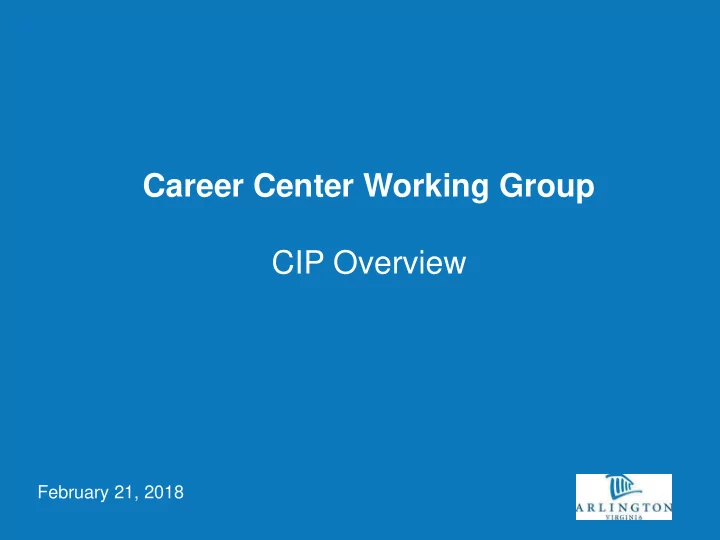

Career Center Working Group CIP Overview February 21, 2018
What is the Arlington County CIP? • Ten year financially-constrained plan for investment in Arlington’s assets totaling $3.3 billion • Covers all areas of infrastructure • Driven by service delivery demands • Balanced between “maintaining what we have” and new investments • Financially sustainable & maintain County’s triple-AAA bond ratings
Where Do We Spend CIP Dollars? Parks & Recreation Schools 6% 15% $ in 000's Stormwater … Parks & Recreation 208,351 6% Transportation Initiatives 1,285,299 39% Metro 280,200 8% Community Conservation & Econ. Dev. 97,050 3% Water & Sewer Government Facilities 282,130 8% Infrastructure Technology & Public Safety 146,364 4% 13% Transportation Initiatives Regional Partnerships 19,142 1% 39% Joint County & Joint County & Schools Projects 23,500 1% Schools Projects Water & Sewer Infrastructure 420,504 13% 1% Stormwater Infrastructure 53,693 2% Regional Partnershi… Schools 510,290 15% TOTAL CIP 3,326,523 Technology & Public Safety 4% Government Community Facilities Conservation & 8% Metro Econ. Dev. 8% 3%
How Do We Pay for the CIP? Adopted FY 17-26 CIP Previously Approved Pay-As-You-Go Funds 7% 11% Other Bonds & Other Funding 5% $ in 000's Developer Pay-As-You-Go 250,176 8% Contributions GO Bonds (County & Schools) 1,092,355 33% 3% Tax Increment Schools Pay-As-You-Go 75,260 2% Financing Master Lease 86,265 3% 2% GO Bonds (County & Utilities Pay-As-You-Go & Bond 284,171 9% Federal & State Schools) Stormwater Tax 28,679 1% Funding 33% Dedicated Transportation Funding 512,205 15% 9% Federal & State Funding 316,746 10% Tax Increment Financing 57,997 2% Developer Contributions 110,390 3% Other Bonds & Other Funding 152,286 5% Previously Approved Funds 359,993 11% Dedicated Total Funding Sources 3,326,523 Schools Pay-As-You- Transportation Go Utilities Pay-As-You- Funding Master Lease Stormwater Tax 2% 15% Go & Bond 3% 1% 9%
How can CIP funding sources be used? • Any capital asset with governmental purposes – some state / fed limitations • Longer useful life assets – must at least be equal to average life of bonds Bonds • GO bonds require voter approval • Examples – facilities, paving, parks, WMATA • Any capital asset with governmental purpose • Financed by General Fund cash contributions PAYG • More flexible in useful life limits • Examples – technology, maintenance capital, planning studies Short Term • Capital assets with useful life of 3-10 years • Bank has security interest in asset Financing • Examples – technology, rolling stock (fleet, fire trucks) • Legally restricted in use for specific purposes Dedicated / • Examples include Transportation (only enhancements); Utilities; Stormwater; Ballston Garage Restricted Funding • Federal / state grants for specific purpose of grant
ABC’s of General Obligation (GO) Bonds • Primary financing source used by County for major general government infrastructure • In Virginia, GO bonds issued by counties require voter approval • Cannot reallocate between referenda questions • Carry full faith and credit of Arlington County • Lowest cost of capital available, especially given Arlington’s bond ratings • Generally interest is tax-exempt to the investor • Arlington’s GO bonds typically have 20 year maturity • Limited by debt capacity guidelines which are viewed as combined for the County & APs • Four primary metrics
Debt Service as % of General Government Expenditures • How much of budget is consumed by FIXED debt service costs – no greater than 10% 12.00% 10.00% 8.00% 6.00% 4.00% 2.00% 0.00% FY 2017 FY 2018 FY 2019 FY 2020 FY 2021 FY 2022 FY 2023 FY 2024 FY 2025 FY 2026
CIP Process & Inputs
CIP Process Background • Biennial process • Aligns with schedule of bond referenda for even-numbered calendar years. • Ten year time horizon • Reflects longer-term nature of major infrastructure projects • Shifted from six year horizon in 2013 • Planning document – can and will change based on changing conditions
CIP Process & Timeline
Other Inputs into CIP Reinvestment projects: • Maintenance capital condition / inventory assessments • Paving condition index Resident Satisfaction Survey Near-Term Impacts of Various Plans: • Master Transportation Plan • Transit Development Plan • Public Spaces Master Plan • Various Sector Plans • Project-Specific Plans – Long Bridge • Stormwater Master Plan • Chesapeake Bay Preservation Plan • Water Master Plan • Water Pollution Control Plant Master Plan • Sanitary Sewer Master Plan • Community Energy Plan • Special service delivery studies – public safety • Economic development
New Pressures & New Process Changes • Metro’s capital needs are increasing dramatically • Arlington County represents approximately 10% of Metro’s capital CIP • Regional solution is needed • Increasing construction costs & rising interest rates • County Manager commitment to conduct additional needs assessments over the next four to six years • JFAC • Expanded community engagement
Key Takeaways • The CIP strives to balance between reinvestment vs. new projects • The CIP covers the entire spectrum of County infrastructure, facilities, and technology and is largely based on service delivery demands • The CIP is flexible, responding to changing priorities & external factors • The CIP is financially sustainable • Debt ratios are moderate and consistent with triple -AAA bond rating standards • Debt levels are balanced against other operating budget needs
Questions?
Recommend
More recommend